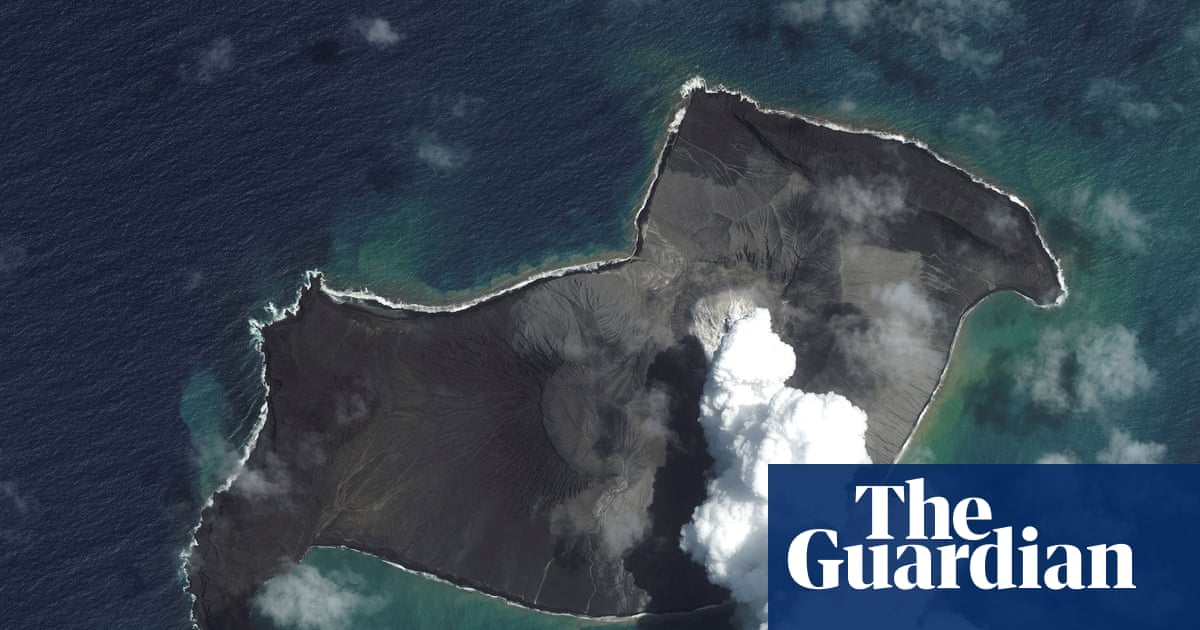For a while, Sam Vea had been smelling sulphur on the air – only mildly infernal, like a distant sniff of hell, but sulphur nonetheless. Still, on the Saturday evening when the explosion happened, he sat up in fright. It sounded so near he thought some cataclysm had occurred right there, in his neighbourhood. The windows trembled. The curtains fell off. Vea peeked out of his house but saw nothing destroyed or on fire, so he looked at his wife and said: “This has to be the volcano.”
Vea and his wife live in Tofoa, which, if you squint and picture Tonga’s main island of Tongatapu as a long, medieval shoe, lies just below the instep, on a gentle rise of earth. They’d just returned home after dropping their daughters at a birthday party, but now Vea dashed to his van to go and collect them. On the way back, the road filled with cars hurrying away from the sea, and tiny pebbles fell from the sky. Not that long before, curious to see what a big volcanic eruption looked like, Vea had watched Dante’s Peak on Netflix. In the movie, he remembered now, a white-hot rock had punched through the roof of a truck and killed Pierce Brosnan’s partner, so he pulled over to wait out the traffic. The skies grew mottled with dust and ash. Drivers got out, took off their shirts and wiped their windshields down so they could see the road ahead. When they reached home, after two and a half hours, Vea sent his children to hide under the bed.
The volcano, with the grand, rolling name of Hunga Tonga-Hunga Ha‘apai, lies 40 miles north of Tongatapu – mostly under the Pacific Ocean but with two spits of land showing above the water, like the ears of a drowned cat. Since its several brief eruptions the previous month, December 2021, Hunga Tonga-Hunga Ha‘apai had continued to gurgle and churn. On that Saturday, 15 January, 2.4 cubic miles of sediment and molten rock shot through its mouth with the force of what scientists call a “magma hammer”, sending a plume of ash at least 35 miles up into the atmosphere. It was the largest atmospheric explosion that modern instruments had recorded, outdoing any nuclear bomb ever detonated. They heard the sound in Alaska. Seven and a half thousand miles away, in the south Indian city of Chennai, meteorologists measured an abrupt spike in atmospheric pressure. It was Hunga Tonga-Hunga Ha‘apai, doing its thing.
On his drive home, Vea had called relatives in the US through Facebook Messenger to let them know he was all right. At some point during their conversation, the line cut out. He assumed the network was overloaded by everybody getting online at the same time. “This is usually a problem for us,” he told me. Vea, DHL’s agent in Tonga, is the president of the Tonga Chamber of Commerce & Industry, and we met in his spare, sunny office in the capital of Nuku’alofa, three streets from the Pacific. The curtains were red, and the sun filtered through in a dull watermelon light.
Vea wears a perpetual expression of mirth, and it was difficult to imagine him as worried as he was on the day the volcano blew up, sitting in his van in the middle of a rain of ash, staring at his suddenly useless phone. He decided he’d try his relatives later, after the traffic online subsided. At home, though, the power was out, and he couldn’t charge his phone, so it was only the next morning, when he tuned in to Radio Tonga, that he learned the country had lost its internet altogether – and with it, all its means of reaching the world beyond the wide, silent water.
In the abyssal depths of the ocean, a data cable is a scrawny, unprotected thing, like a snail divested of its shell. Its core consists of fibres of glass, each roughly as thick as a human hair, through which light transmits information at roughly 125,000 miles per second. Around the fibres, there is first a casing of steel for protection, then another of copper to carry
Continue Reading on The Guardian
This preview shows approximately 15% of the article. Read the full story on the publisher's website to support quality journalism.
